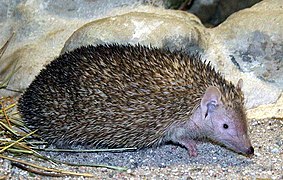|
Promoniliformis
Promoniliformis is a monotypic genus of acanthocephalans (thorny-headed or spiny-headed parasitic worms) containing a single species, Promoniliformis ovocristatus, that infests tenrecs in Madagascar. The genus Promoniliformis Dollfus and Golvan, 1963[1] is characterized by possessing two distinct kinds of proboscis hooks.[2] There is only one species in this genus. TaxonomyPromoniliformis ovocristatus was originally named Echinorhynchus ovocristatus by von Linstow in 1897 and renamed Moniliformis ovocristatus by Petrotschenko in 1958 and later Heteracanthorhynchus echinopsi by Hörchner in 1962. In 1963 Dollfus and Golvan introduced the present genus and species.[3] P. ovocristatus is the type species.[4] The National Center for Biotechnology Information does not indicate that any phylogenetic analysis has been published on Promoniliformis that would confirm its position as a unique genus in the family Moniliformidae.[5] DescriptionThe largest female was 222 mm long and 1.1 to 1.5 mm wide whereas the largest male was much smaller at 65 mm long and 0.85 to 1 mm wide. There is no pseudosegmentation as seen in Moniliformis species. The proboscis is 0.550 mm long and 0.250 to 0.300 mm wide at the widest point. The proboscis contains 20 to 24 longitudinal rows of 8 to 10 hooks each with the 4 or 5 superior hooks being large and possessing well-developed roots whereas the 4 or 5 inferior hooks are small and have reduced roots. The receptacle measures 0.550 to 0.650 mm long with a maximum width of 0.125 mm. It is the type species.[1] DistributionThe distribution of P. ovocristatus is determined by that of its hosts. P. ovocristatus has been found in Madagascar.[6] Hosts The life cycle of an acanthocephalan consists of three stages beginning when an infective acanthor (development of an egg) is released from the intestines of the definitive host and then ingested by an arthropod, the intermediate host. Although the intermediate hosts of Promoniliformis are not known, without exception for the order Moniliformida, this intermediate host is an insect. When the acanthor molts, the second stage called the acanthella begins. This stage involves penetrating the wall of the mesenteron or the intestine of the intermediate host and growing. The final stage is the infective cystacanth which is the larval or juvenile state of an Acanthocephalan, differing from the adult only in size and stage of sexual development. The cystacanths within the intermediate hosts are consumed by the definitive host, usually attaching to the walls of the intestines, and as adults they reproduce sexually in the intestines. The acanthor are passed in the feces of the definitive host and the cycle repeats. There are no known paratenic hosts (hosts where parasites infest but do not undergo larval development or sexual reproduction) for Promoniliformis.[9] Promoniliformis ovocristatus has been found parasitizing tenrecs[6] including the tailless tenrec (Tenrec ecaudatus) and the lesser hedgehog tenrec (Echinops telfairi). There are no reported cases of P. ovocristatus infesting humans in the English language medical literature.[8]
NotesReferences
|
||||||||||||||||||||||||||||

